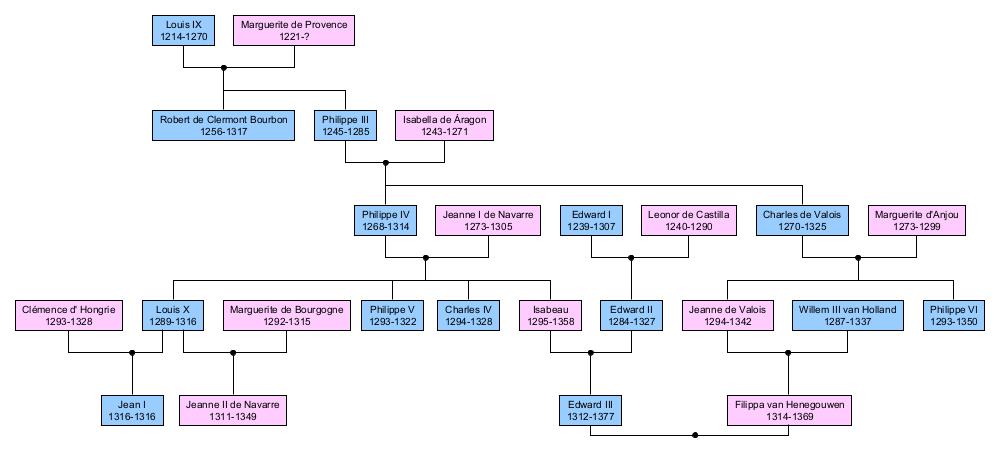The Salic Law is not directly referred to in Marlowe’s plays, but it is not irrelevant to the understanding of the historical context in Edward II and The Massacre at Paris.
The Lex Salica are legal decrees of the Merovingian Clovis I from the beginning of the 6th century. Among other things, it states that women cannot inherit landed property.
Philippe IV of France had three sons and one daughter. Isabeau marriedEdward II. of England. When her eldest brother Louis X died in 1316, there were a daughter named Jeanne from his first marriage and a pregnant second wife. Until her confinement, her brother-in-law Philippe took over the regency. The child was a son (Jean I), but survived only a few days. According to the succession, the crown should have gone to Jeanne and thus, for the first time in France, to a woman. Her uncle did not want to give up the throne. He had the Estates-General make a few legal dodges, and with Jeanne all the women of the royal family lost their claims to the French crown for now and for ever. Philippe V officially became King of France. Unfortunately, it is not known whether he was really angry when he died in 1322, leaving only daughters. His brother Charles IV was crowned. He died in 1328 without male heirs. Now things were really complicated. Although women were excluded from the succession to the throne, there was no regulation on how to proceed with agnates (descendants from the male line) and cognates (descendants from the female line). If the crown could go to a man who was related to the royal house in the female line, Edward III, the son of Isabeau and Edward II, would be next in line to the throne. Again, in France, wise men came together and declared that women who have no right of inheritance cannot bequeath it. Agnates were thus also excluded from the right of inheritance. At first sight, an understandable decision. The French did not want an Englishman as king. Apart from that, there was no legal basis for this decision. The 1317 Act was occasion legislation and did not deal with the claims of the cognates at all. Although the Lex Salica only mentions landed property and cognates are not mentioned either, it was used in the following decades as evidence of a lived tradition of inheritance in France.1 Then the term began to take on a life of its own and the "Salic Law" became synonymous for a succession that categorically excluded women and their descendants.
In France, at any rate, the rule of the House of Capet ended in 1328. The crown went to the closest male relative of Charles IV and Isabeau, their cousin Philippe de Valois, whose father had been Philippe IV’s younger brother. Edward III conditionally agreed to this arrangement. In 1337, however, a conflict arose with Philippe VI. From then on, Edward III also claimed the French crown: the Hundred Years' War began.

Family tree Lex Salica France. Private property. © 2022
For the French, the Salic Law became a cornerstone of the monarchy and it gave rise to the title "prince du sang". This title referred to all the male agnates of Louis IX (1214-1270), strictly speaking the Valois and Bourbon families including the collateral lines. Within the princes du sang, the same rules of succession applied as in the line of succession to the throne. The first prince du sang was always the next heir to the throne in case the main male line should die out. Louis XII, who had only two daughters, solved the problem by marrying the eldest to the first prince du sang, François de Valois, Comte d’Angoulême. In 1515, François I became king and ensured the continuity of the House of Valois for the time being with his male descendants.
Henri de Navarre was a direct descendant of the Capetians through his mother Jeanne III and married Margueritethe sister of the reigning king Charles IX from the House of Valois. This meant that he was as far from the throne as a Parisian cobbler. His father, Antoine de Bourbon, however, was a direct male descendant of Robert de Clermont Bourbon, a son of Louis IX. This fact alone made Henri de Navarre the next claimant to the French throne should the Valois die out in the male line, which, contrary to expectations, happened in 1589.
- Taylor (2001)↩︎
